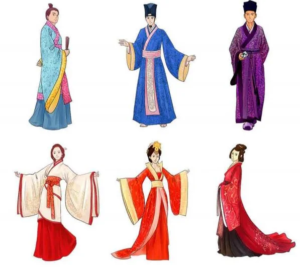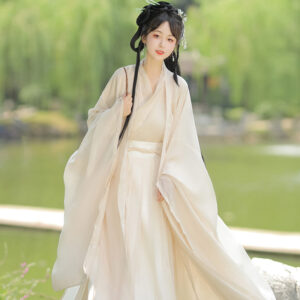

There were notable regional differences in Hanfu styles, reflecting China’s vast geography, diverse climate, and the cultural influences of various ethnic groups and neighboring regions. While Hanfu was generally defined by the traditional clothing of the Han Chinese, different regions adapted and modified Hanfu to suit local tastes, needs, and environmental conditions. Here’s an overview of the main regional differences in Hanfu styles throughout China’s history:
1. Northern vs. Southern Hanfu Styles
China’s geography is broadly divided into the northern and southern regions, which influenced the development of Hanfu styles due to differences in climate, cultural interactions, and societal priorities.
- Northern Hanfu Styles: Northern China, with its colder climate, necessitated heavier and warmer clothing. Hanfu in the north often used thicker materials such as wool, fur, and heavier silks to protect against the cold. Robes tended to be layered, with wide sleeves that could easily be wrapped around the body for warmth. Influences from the nomadic tribes on the northern borders, such as the Xiongnu and later the Mongols, also introduced elements like fur collars and shorter, more practical garments for horseback riding.The Northern dynasties, especially during the Song and Yuan periods, also saw influences from foreign cultures that adapted Hanfu styles for more functional purposes while maintaining traditional Han design elements.
- Southern Hanfu Styles: In contrast, the warmer and more humid climate of southern China led to lighter fabrics being used, such as silk, gauze, and linen. Southern Hanfu styles were often more fluid and elegant, favoring flowy robes and thinner materials. This reflected the region’s agricultural wealth, including the production of high-quality silks, and the aesthetic preferences of the Southern elite, who valued artistic and scholarly refinement.Southern China was also a hub of commerce and cultural exchange, particularly along the Yangtze River and coastal areas. This cosmopolitan atmosphere contributed to the development of more elaborate and decorative Hanfu styles, particularly in wealthy port cities.
2. Court vs. Provincial Styles
There were significant differences between the styles of Hanfu worn at the imperial court and those worn in more rural or provincial areas.
- Imperial Court Styles: The clothing at the imperial court, particularly during the Tang, Song, and Ming dynasties, was often more formal and elaborate than what was worn by common people or those in the provinces. Imperial court Hanfu was characterized by the use of rich silks, brocades, and embroideries, with strict regulations on who could wear certain colors, patterns, and materials. For example, bright colors like yellow were reserved for the emperor, and specific designs like dragon or phoenix motifs were restricted to royalty or high-ranking officials.Court styles set the fashion trends for the rest of the country, but because of the strict rules around attire at court, people in provincial areas had more flexibility and freedom to incorporate regional influences into their dress.
- Provincial Styles: In rural or provincial areas, Hanfu was generally more practical and less ornate. Materials were chosen based on availability, and the designs were influenced by local traditions and customs. For example, in agricultural regions, people favored simpler, more durable clothing made from cotton or hemp, which was better suited for physical labor. Decorations and accessories were often influenced by local craftsmanship, including unique embroidery patterns or weaving techniques passed down through generations.Provinces farther from the political and cultural center of the capital, like those in the far southwest or on the northern frontier, developed distinctive Hanfu styles that were sometimes markedly different from those at the court.
3. Ethnic Minority Influences
While Hanfu is associated with the Han Chinese majority, China has historically been home to many different ethnic groups, and their clothing traditions influenced Hanfu styles, especially in border regions.
- Tibetan and Western Regions: In regions bordering Tibet and Central Asia, such as Sichuan, Qinghai, and Gansu, the local Hanfu styles often incorporated elements from Tibetan and Central Asian clothing. For instance, the use of heavier wool and furs in these regions was common, as well as styles that allowed for greater mobility in mountainous or rugged terrain. The influence of Buddhism, which spread from Tibet and India, also introduced symbolic motifs such as the lotus flower into the design of Hanfu in these regions.
- Southern Minority Groups: In southern China, especially in areas like Yunnan, Guizhou, and Guangxi, the Han Chinese population coexisted with various ethnic minorities such as the Miao, Zhuang, and Yao. This resulted in a fusion of clothing styles, with Hanfu in these regions reflecting vibrant colors, bold embroidery, and complex patterns, elements that were characteristic of the traditional dress of these minority groups. The use of silver accessories, bright dyes, and complex weaving techniques in southern Hanfu is often attributed to the artistic influence of these minority cultures.
4. Influence of Trade and Coastal Regions
China’s coastal regions, particularly during the Tang and Song dynasties, were centers of international trade, which brought foreign goods and cultural influences into Hanfu styles.
- Tang Dynasty Coastal Cities: During the Tang Dynasty (618–907 CE), cities like Guangzhou and Quanzhou were major trading hubs where merchants from Persia, India, and the Arab world came to exchange goods. As a result, the Hanfu styles in these cities began to incorporate elements from foreign cultures, including the use of more vibrant colors, decorative scarves, and new fabrics like imported silks. Women in these areas also began to wear more revealing styles, reflecting a fusion of foreign influences with traditional Han attire.
- Song Dynasty Coastal Influence: The Song Dynasty (960–1279 CE) saw an expansion in maritime trade, and cities like Hangzhou became cosmopolitan centers of commerce and culture. The growing wealth of merchants in these coastal regions led to the development of more luxurious Hanfu styles, featuring intricate embroidery, flowing robes, and new dyeing techniques. These coastal styles were often more relaxed and artistic, in contrast to the stricter, more formal attire worn at court.
5. Regional Color Preferences
Different regions of China also had varying preferences when it came to the colors used in Hanfu, influenced by local aesthetics, symbolic meanings, and the availability of natural dyes.
- Northern Color Palette: In northern China, the preferred color palette for Hanfu was generally darker and more subdued, reflecting the harsher environment and the influence of nomadic cultures. Black, dark blue, and earth tones were common in the clothing of northern officials, scholars, and military personnel. These colors also carried symbolic weight, with black often associated with Heaven and authority in Confucian thought.
- Southern Color Palette: Southern China, particularly in the fertile regions along the Yangtze River, had a much brighter and more vibrant color palette. The use of lighter, pastel shades such as pale pink, soft green, and sky blue was popular, especially in the clothing of women. The availability of high-quality silk and natural dyes in the south contributed to this colorful aesthetic. Southern Hanfu styles were often more decorative, reflecting the region’s wealth and artistic traditions.
6. Urban vs. Rural Styles
Urbanization during certain dynasties, particularly the Song Dynasty, led to the rise of urban-specific fashion trends that contrasted with rural Hanfu styles.
- Urban Hanfu: In cities like Kaifeng and Hangzhou, where the merchant and scholar classes flourished, fashion became a status symbol. Urban dwellers often adopted more elaborate Hanfu styles, incorporating accessories like jade hairpins, embroidered belts, and ornamental headpieces. These city styles were influenced by the latest trends in the capital and international trade, making them more luxurious and often more experimental.
- Rural Hanfu: In contrast, rural Hanfu styles remained relatively unchanged, focusing on practicality and durability. Farmers and laborers typically wore simple robes made of cotton or hemp, and their attire was designed for work rather than fashion. Even in more remote rural regions, Hanfu remained traditional, with fewer outside influences from foreign cultures or court fashion.
Conclusion: The Diversity of Hanfu Across Regions
Regional differences in Hanfu styles showcase the incredible diversity within China’s borders, reflecting the country’s varied climates, social structures, and cultural exchanges. While there were overarching trends in Hanfu design that united the Han Chinese across dynasties, local adaptations gave rise to distinctive regional styles, from the elegant, lightweight robes of the south to the fur-lined, practical garments of the north. Each region contributed its unique flair to the evolution of Hanfu, enriching its history and ensuring its lasting influence on Chinese culture.
Share this post
Recent Posts


What were the key features of Hanfu during the Tang Dynasty?

How did Hanfu styles vary during different Chinese dynasties?

What accessories are typically worn with Hanfu?

How do you choose the right Hanfu for different seasons?

Newsletter
Popular Categories
Related Post
Sed aliquam, tortor et sodales malesuada, lorem leo luctus tellus, quis interdum eros nibh in nunc. Cras dignissim malesuada, lorem leo luctus

What are the winter hanfu called?

What were the key features of Hanfu during the Tang Dynasty?

How did Hanfu styles vary during different Chinese dynasties?


